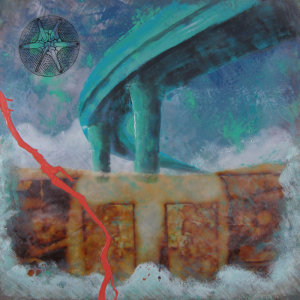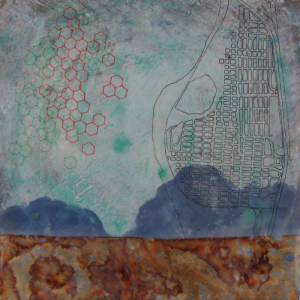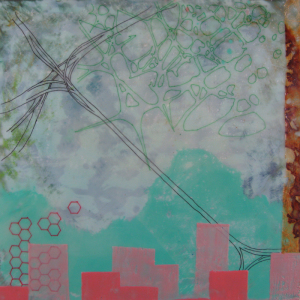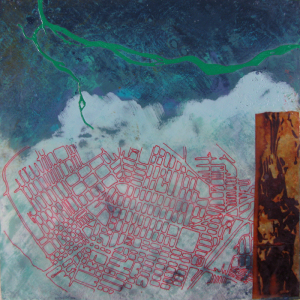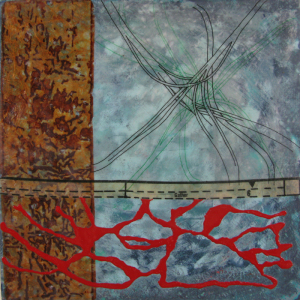It seemed for a while that I was making lots of art that was disconnected and lacking in any deeper meaning (at least for me). But I kept experimenting and following what interested me and trusted that as I got better as an artist things would come together more. In 2013 I started to plan a series of work about the city of Portland as a living organism, incorporating biology and city landmarks. It was also around this time that I purchased my first house and began to explore my new neighborhood of St. Johns. I think that putting down roots in Portland made me look the city in a different way.
There were several podcasts that I listened to around this time that influenced me. The first was the show Mapping from This American Life. It was about what maps include and exclude, and different ways of mapping the world around you. The second was a show called Emergence from Radiolab about how cities and insect colonies are built from the ground up by the collective and it introduces the concept of “the swerve” that creates certain areas of the city. The other interesting podcast was another from Radiolab called Cities, and is about what makes a city “alive”. If you’re interested in these podcasts you should check out the books that are mentioned in them: “Everything Sings, Maps for a Narrative Atlas” by Dennis Wood, and “Emergence: The Connected Lives of Ants, Brains, Cities, and Software” by Steve Johnson.
After listening, thinking, sketching, and photographing, I started working on the series of paintings I’m titling “Swerve”. It’s a mixture of maps, intersecting freeway overpasses, rivers, water diatoms, ant tunnels, bridges, bone tissue, chrysalises, honeycombs, and buildings. It feels more important and meaningful to me than my previous work, and I finally feel like I have something to say with my art. I can see a million different directions this can go, and it feels like a coming together of all the separate interests I had been following. Here are some of the first pieces from the series and the artist statement that accompany them:
“At the time I bought my house in Portland I began thinking more deeply about the city in which I’m putting down roots. When I’m fascinated with a city, I start thinking of it as a living organism. I picture its rivers as arteries that carry life-blood, its bridges as tendons pulling the banks together, its electrical wires as neurons zapping the signal along, and its tall buildings like a spiny outer shell that protects the city within. I start to recognize it in the structure of cells, water diatoms, and human anatomy. The city seems alive and pulsing with energy and consciousness. I’m also intrigued by the concept of emergence in city structure, or finding patterns that emerge from the chaos. Economist Jeffrey Goldstein defined emergence as, “the arising of novel and coherent structures, patterns and properties during the process of self-organization in complex systems”. Looking at maps of freeway systems or the overviews of neighborhoods you can begin to see these patterns emerging. But how did they appear and who planned them? Are they the result of a top-down urban development project written by a consultant, or are they instead the product of “the swerve”? The idea of “the swerve” is literally people swerving from their usual route through the city when they see something of interest. This gradually changes traffic patterns, which in turn leads to more businesses, more swerving, and so on until you have an arts district or a collection of food carts. It’s a poetic concept that, like the winding tunnels of ants or the intricate structure of honey combs, our city is planned from the bottom-up. It’s built by the individual actions of the people who live there, creating a more complex whole.”

